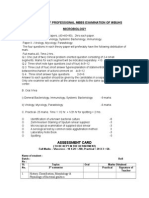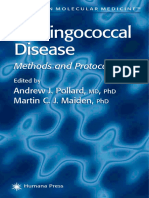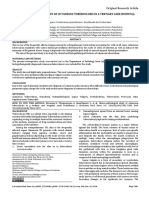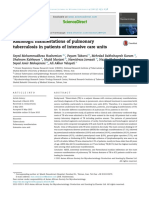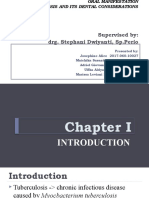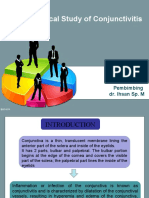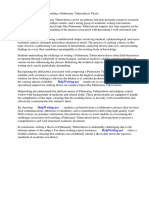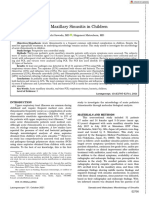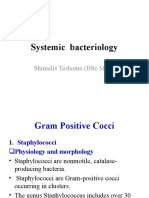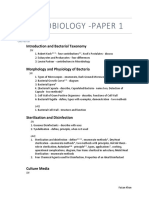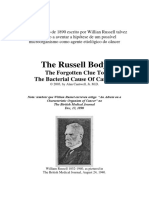Professional Documents
Culture Documents
To Study The Correlation Between Fine Needle Aspiration Cytology, Smear and Culture in Tubercular Cervical Lymphadenitis in Central India Population
Original Title
Copyright
Available Formats
Share this document
Did you find this document useful?
Is this content inappropriate?
Report this DocumentCopyright:
Available Formats
To Study The Correlation Between Fine Needle Aspiration Cytology, Smear and Culture in Tubercular Cervical Lymphadenitis in Central India Population
Copyright:
Available Formats
Volume 8, Issue 2, February – 2023 International Journal of Innovative Science and Research Technology
ISSN No:-2456-2165
To Study the Correlation between Fine
Needle Aspiration Cytology, Smear and
Culture in Tubercular Cervical Lymphadenitis
in Central India Population
Dr. Kuldeep Pratap Patel (Ass. Professor), Dr. Atul Kumar Khare (Ass. Professor), Dr. Jaymhlal Arya (Sr. Resident)
Abstract:- urban hospitals. Simplicity of these techniques (FNAC &
Introduction: Tuberculosis is a specific infectious disease Smear) combined with early availability of results and
caused by bacteria belonging to the "Mycobacterium good diagnostic accuracy warrants their clinical
tuberculosis complex".It presents a great social and application.Missed cytological diagnosis and isolation of
economic problem and is one of the major factors non-tuberculous mycobacteria justify culture studies on
responsible for the high morbidity and mortality in all suspected tuberculous lymphadenitis cases.
India. The incidence of tuberculous cervical
lymphadenopathy now accounts for two third of the I. INTRODUCTION
extra pulmonary tuberculous lymphadenopathy. Most of
these are supposed to be tuberculous in origin because of Tuberculosis is a specific infectious disease caused by
greater incidence of pulmonary tuberculosis in our bacteria belonging to the "Mycobacterium tuberculosis
country. At the same time there are other causes of complex". The complex includes M. tuberculosis, M. bovis,
lymph-adenopathy which are usually misdiagnosed as M. africanum, M. microti, M. fortuitum, M. kansasii and M.
tuberculosis. It has been a common problem for both to scrofulascium. Tuberculosis is one of the commonest
clinicians as well as pathologist from to diagnose diseases remains a world-wide public health problem, even
tuberculosis. today. It presents a great social and economic problem and
is one of the major factors responsible for the high morbidity
Methos and materials: The present work is carried out and mortality in India.
in 100 clinically suspected cases of tuberculous cervical
lymphadenitis attending E.N.T., Surgery, Paediatrics The disease is usually chronic with varying clinical
and Medicine Department of central India institute as an manifestations. The disease primarily affects lungs and
outdoor/indoor patient during the period of one year. causes pulmonary tuberculosis. It can also affect intestine,
Patients with enlarged cervical lymph nodes with a meninges, bones and joints, lymph nodes, skin and other
history suggestive of tuberculosis were included after tissues of the body. Peripheral tuberculous lymphadenitis is
taking an informed consent. the most common form of extrapulmonary tuberculosis,
most commonly affects the cervical lymph node. (32)It is
Results: Study was done on 100 clinically suspected cases widely prevalent particularly in the malnourished,
of tuberculous cervical lymphadenitis, Tuberculosis was undernourished anddebilitated children.
diagnosed in 57% cases by FNAC, smear and culture
together, the maximum incidence of tuberculosis was The incidence of tuberculous cervical
observed in second and third decades, Females were lymphadenopathy now accounts for two third of the extra
more affected (64%) than males with the ratio of 1:2.3. pulmonary tuberculous lymphadenopathy. Most of these are
By FNAC 42% accuracy was obtained, 30% cases were supposed to be tuberculous in origin because of greater
AFB smear positive in our study this rate of incidence is incidence of pulmonary tuberculosis in our country. At the
nearer to other authors. In our culture study, 57 cases same time there are other causes of lymph-adenopathy
were diagnosed as tuberculous and 4 cases as non- which are usually misdiagnosed as tuberculosis.
tuberculous cervical lymphadenitis. Culture positive was Histopathological study requires considerable time and
higher in granulomatous necrotic lesions. Sensitivity, it may complicate after biopsy. Therefore, the need for less
specificity and predictive values of culture study were traumatic and some faster technique (AFB staining, FNAC)
significantly higher than FNAC and smear. These has been felt in this field and fine needle aspiration of
methods of investigation needs considerable experience cervical lymph nodes for cytology, AFB staining and culture
and confidence of a pathologist who perform the could be a possible. (27,33).The Gold Standard for diagnosis
procedure for a better result. When culture was taken as of tuberculous lymphadenitis is the demonstration of
Gold Standard, cytology was found to be more sensitive mycobacteria in biopsy specimen by smear or culture. The
than smear. sensitivity of these conventional methods is, however low
Conclusions: From this study we concluded that Both when the specimen contains only a small number of
FNAC and smear are quick, simple, less traumatic and organisms. Some studies demonstrated the accuracy of these
cost-effective methods and used as a routine conventional bacteriologic methods is less than 50% (9,31).
investigating procedure in OPD of urban and semi-
IJISRT23FEB976 www.ijisrt.com 2035
Volume 8, Issue 2, February – 2023 International Journal of Innovative Science and Research Technology
ISSN No:-2456-2165
Fine needle aspiration avoids the physical and The needle is then inserted deep into the lymph node
psychological trauma which occasionally encountered after and plunger of syringe is retracted, creating the vacuum
biopsy, general anaesthesia, surgical operation and in the system while the needle is guided in a straight
hospitalization. Fine needle aspiration being a simple line through the lesion. The needle is moved back and
outpatient procedure is well accepted by patients and has forth up to 1-3 mm of depth in all possible directions
practically no complications. The efficacy of FNAC as a while maintaining the negative pressuresufficient, so
diagnostic procedure is already established and it has been that the cells get dislodged from the lymph node and get
found as effective as biopsy, particularly in cases of access into the aspirating needle.
tubercular lymphadenitis. The aim of FNAC is to confirm The pressure in the syringe isequalized before the
the nature of lesion within 24 hours or less. Cytodiagnosis needle is withdrawn from the lesion. There after needle
by aspiration of cervical lymph nodes was begun by Guthrie along with the syringe is withdrawn from the lesion and
in 1921. brought near the glass slides. The needle is then
removed from the syringe and air is filled in the syringe
Microscopic examination of smear for AFB by Zeihl by withdrawing the plunger backwards. Then, needle is
Neelsen's staining provides only presumptive evidence of again reconnected to the syringe. The material in the
tuberculosis. It was discovered by Ehrlich. About 10,000 needle and syringe is expelled onto the glass slide in a
cells are needed for smear positive result.Both FNAC and single drop at one end of slide.
smear examinations are almost trivial safe, cost effective The lymph node aspirate is smeared on glass slide by
and faster techniques.Culture is very sensitive for detection using cover slip or another dry slide.
of tubercle bacilli and may be positive with as few as 10-100
Smear is fixed immediately in methanol for 10 minutes.
bacilli in the sample. Cultures for tubercle bacilli are
Then stain with Giemsa stain or H&E stain. After 10-15
difficult and time consuming.
minutes, stained slides are washed in running tap water.
The study is based on 100 patients with cervical Then dry the smear and mount with cover slip.
lymphadenitis of different age group, rural as well as urban
Result:
patients irrespective of their social standing and religion
On high power microscopic examination smear shows
selected at random were included in the study
variable number of Epitheloid granuloma, Epitheloid cells,
II. AIMS & OBJECTIVES lymphocytes, macrophages, polymorphs and Langhan's
giant cells against necrotic background.
This prospective cohort study done to evaluate the
incidence of cervical lymphadenitis in tuberculosis in central B. ACID FAST STAIN (ZIEHL NEELSEN'S TECHNIQUE):
India population for one-year periods in 100 patients. The
Procedure:
aims are-
-Smear made in the slide from lymph node aspirate.
To assess the diagnostic role of FNAC, Smear and culture
-Kinyoun's Carbol Fuchsin solution at 56°C – 10-15
of fine needle aspiration done on clinically suspected
min
cases of tuberculous cervical lymphadenitis.
Or
To know different clinical presentation of tubercular
At room temperature- 30 min
cervical lymphadenitis.
-Heating till steam rose – 5 min
To know the most affected cervical lymph node group.
-Then wash with Tap water – 30 sec
To detect individuals and comparative sensitivity,
specificity and predictive values of each diagnostic -1% acid alcohol or 20% H₂So4, solution – 8-10 dips
investigations. -Wash with running tap water – 2-4 min
-10% methylene blue solution – 1-2 dips
III. MATERIAL AND METHOD -95% alcohol – 1 min
The present work is carried out in 100 clinically Result:
suspected cases of tuberculous cervical lymphadenitis Mycobacterium tuberculosis were stained bright red
attending E.N.T., Surgery, Paediatrics and Medicine remaining field was stained blue. Acid fastness because of
Department of central India institute as an outdoor/indoor high content and variety of lipids, fatty acids and higher
patient during the period of one year. Patients with enlarged alcohol found in tubercle bacilli.
cervical lymph node (s) with a history suggestive of
tuberculosis were included after taking an informed consent. C. CULTURE OF MYCOBACTERIA:
Relevant clinical details were recorded. Fine needle
Procedure:
aspiration was performed aseptically.
The contaminated material is mixed with 4% NaOH and
A. FINE NEEDLE ASPIRATION: left for 20 min.
Technique of lymph node aspiration:
Then, it is centrifused and sediment is inoculated on
The aspiration is done by 20 ml disposable syringe with
slopes of L-J media at37°C under 5% carbon dioxide.
22- gauge needle attached air tightly.
Colonies appear in 2-3 weeks and may be delayed by for 6-8
The skin is cleaned with an antiseptic spirit swab and
weeks. Culture examined every week for presence of growth
the suspected lymph node is fixed with one hand in a
upto 8 weeks. All the positive cultures were first confirmed
position favourable for aspiration.
IJISRT23FEB976 www.ijisrt.com 2036
Volume 8, Issue 2, February – 2023 International Journal of Innovative Science and Research Technology
ISSN No:-2456-2165
for their acid fastness and subsequently identified by using Lowenstein-Jensen's media:
the following criteria and biochemical tests-rate of growth, It is a solid media, most widely used for routine culture
type of growth niacin test, catalase test (68°C), nitrate for M. tuberculosisand when the material is
reduction test and aryl sulphatase test. contaminated with other organisms.
It consists of coagulated Hen's egg, mineral salt
Result: solution, asparaginase andmalachite green. Malachite
Mycobacterium tuberculosis form large, rough and green prevents growth of other bacteria.
orange yellow colonies whereas mycobacterium bovine
produces small, smooth, flat, colourless anddiscrete growth. E. BIOCHEMICAL REACTIONS:
Several biochemical tests have been described for the
Acid fast stain: identification ofmycobacterial species.
Kinyoun's Carbol Fuchsin Solution; Niacin Test; Human bacilli form Niacin when grown on
Basic fuchsin 4 gm an egg medium (L-J Medium). The human bacilli give a
Phenol crystal (melted) – 20 ml positive reaction, while the bovine type is negative.
Distilled water - 100 ml Nitrate Reduction Test: This is positive with M.
tuberculosis and negative with M. bovis. This test is
Decolourising agent: weakly positive with some atypical mycobacteria like M.
Acid alcohol solution kansasii and M. fortuitum.
Concentrated hydrochloric acid – 1 ml
Catalase Test: Most atypical mycobacteria are strongly
70% alcohol - 99 ml
catalase positive while tubercle bacilli are weekly
20% H-So4 solution. positive in comparison. e.g. M. kansasii, M.
scrofulascium and M. fortuitum.
Counter Stain: Peroxidase Test Tubercles bacilli give positive
Methylene blue solution: peroxidase test but atypical mycobacteria are negative.
Methylene blue:1.4 gm Aryl Sulphatase Test: This is formed by atypical
95% alcohol; 100 ml mycobacteria only. The organisms are grown in 0.001 M
tripotassium phenolphthalein disulphate. 2N NaOH is
Giemsa Stain. added drop by drop to the culture. A pink colour
Fixatives: indicates a positive reaction. e.g., M. fortuitum.
95% alcohol, Methanol, Formalin, Air, Heat
D. CULTURE MEDIA:
Different types of culture medias are used for growth of
mycobacterium tuberculosis. Lowenstein Jensen is most
commonly used media.
Types:
Solid media (L-J media, Dorset egg media, petragnani
media).
Blood media (Tarshish media).
Serum (Loffler's serum slope media, potato and Dubo's
media).
IV. OBSERVATIONS
S. NO. AGE [YEARS] NO. OF NON- NO. OF TOTAL NO OF
TUBERCULAR TUBERCULAR LYMPHADENOPATHY
CERVICAL LYMPH CERVICAL LYMPH
NODES CASE NODE CASES
1 1-10 4 7 11
2 11-20 10 23 33
3 21-30 7 19 26
4 31-40 12 4 16
5 41-50 6 1 7
6 51-60 3 2 5
7 61-70 1 1 2
TOTAL 43 57 100
Table 1: Age Distribution Of The Patients With Cervical Lymph
Most common affected age group are middle age group.
IJISRT23FEB976 www.ijisrt.com 2037
Volume 8, Issue 2, February – 2023 International Journal of Innovative Science and Research Technology
ISSN No:-2456-2165
S. NO AGE MALES FEMALE TOTAL
1 1-10 3 8 11
2 11-20 10 23 33
3 21-30 9 17 26
4 31-40 6 10 16
5 41-50 2 5 7
6 51-60 4 1 5
7 61-70 2 0 2
TOTAL 36 64 100
Table 2: Sex Distribution Of Patient With Cervicaln
Females are more affected than males.
Cervical Lymphadenitis MALE PERCENTASE FEMALE PERCENTASE
Tubercular cervical lymphadenitis (57 cases) 17 29.82% 40 75.44%
Non- tubercular cervical lymphadenitis [43 19 44.19% 24 55.83%
cases]
Table 3: Sex Distribution Of Patient With Tubercular And Non- Tubercular Cervical Lymphadenitis
Symptoms No. of cases Percentage
Painless swelling in neck 100 100
Low grade fever 23 23
Cough 34 34
Loss of appetite 26 26
Loss of weight 32 32
Sore throat 41 41
Common cold 34 34
Sinus formation 1 1
Discharging sinus 1 1
Table 4(A): Presenting Symptoms Of Cases Of Cervical Lymphadenitis
Symptoms No. of cases Percentage
Painless swelling in neck 57 100
Low grade fever 42 73.6
Cough 23 40.3
Loss of appetite 21 36.8
Loss of weight 34 59.6
Sore throat 11 19.3
Common cold 28 49.1
Table 4(B): Presenting Symptoms Of Cases Of Tubercular Cervicallymphadenitis
Most common presenting symptom of cervical lymphadenopathy is painless swelling in neck followed by sore throat while
most common presenting features of tubercular cervical lymphadenitis is painless swelling over neck followed by low grade fever.
Total no. of cases of tubercular Cervical group of lymph nodes No. of cases
cervical lymphadenitis involved
Upper deep cervical [post. Triangle] 51
Submandibular 24
100 Supraclavicular 17
Submental 6
Jugulodiagastric 2
Table 5(A): Group-Wise Distribution Of Cervical Lymph Nodes
Total no. of cases of tubercular Cervical group of lymph nodes No. of cases
cervical lymphadenitis involved
Upper deep cervical [post. Triangle] 33
Submandibular 10
57 Supraclavicular 11
Submental 3
Jugulodiagastric
Table 5(B): Group-Wise Distribution Of The Tubercular Cervical Lymph Nodes
IJISRT23FEB976 www.ijisrt.com 2038
Volume 8, Issue 2, February – 2023 International Journal of Innovative Science and Research Technology
ISSN No:-2456-2165
Most common lymph nodes group of neck involved is upper deep cervical followed by submandibular group in cervical
lymphadenitis.
V. INVESTIGATIONS
A. FNAC: On the basis of cytology, cervical lymphadenitis can be divided into two groups, tubercular and non-tubercular.
Major cytological features No. of cases Lymphocytes Giant cells Macrophages
Epitheloid cells granuloma without necrosis 10 8 10 7
Epitheloid cells granuloma with necrosis 31 31 28 30
Necrosis without epitheloid cells granuloma 1 1 1 1
Total 42 40 39 38
Table 6: Correlation of Major Cytologic Features with Presence of Various Cellular Constituents
The most common cytological features were the B. SMEAR EXAMINATION (AFB STAINING)
presence of Epitheloid cells granulomas, Langhan's giant Increase in AFB positivity was noticed in the presence of
cells, lymphocytes, macrophages and necrosis. increasing degree of necrosis. AFB smear was positive in
65.85% of necrotic lesions and 5% of non- necrotic lesions.
The epitheloid cell granulomas were present in 41 A lower rate of positivity was observed with presence of
cases (97.6%), multinucleate giant cells were detected in 39 granulomatous features alone while necrosis was found to be
cases (92.8%) and macrophages weredetected in 38 cases associated with increasing AFB smear positivity (70.97%).
(90.47%). Appreciable lymphoid cells were noticed in 40 The overall AFB smear positivity was 30% (30/100).
cases (95.2%).
C. CULTURE OF MYCOBACTERIA:
The number of cases associated with epithelial cell On Lowenstein Jensen's culture mycobateria were
granuloma and necrosis were 31 (73.8%), without necrosis isolated in 61 cases, of which 57 (93.4%) were identified as
were 10 (23.8%) and only one case was associated with M. tuberculosis and 04 (6.5%) as non- tuberculous
necrosis. mycobacteria. On further speciation of NTM, two were as
M.kansassi, one M.scrofulascium and one M.fortuitum.
Culture positivity was higher in granulomatous necrotic
lesions (87%). The minimum incubation time for isolation
of M. tuberculosis was 21 days and the maximum was 42
days (mean 29 days).
Cytodiagnosis Cytological findings Number Smear Culture Tubercular Non-
positive positive mycobacteria tubercular
mycobacteria
Suggestive of Epitheloid cells granuloma 10 0 0 0 0
tuberculosis without necrosis [group-1]
Epitheloid cells granuloma 31 22 29 2 2
with necrosis [group-2]
Epitheloid cells granuloma 1 0 1 1 0
with necrosis [group-3]
Suppurative Necrosis with neutrophils 9 5 9 7 2
Non-specific 36 3 18 18 0
lymphadenitis
Insufficient aspirates 13 0 4 4 0
Total 100 30 61 57 4
Table 7: Comparision of Cytological and Mycobacterio logical findings
FNAC 42%
Smear 30%
Culture 61%
Table 8: Individual Positivity Rate Of Investigations
IJISRT23FEB976 www.ijisrt.com 2039
Volume 8, Issue 2, February – 2023 International Journal of Innovative Science and Research Technology
ISSN No:-2456-2165
Species Number Growth Types of growth Niacin Catalase Nitrate Aryl
rate test test reduction test sulphatase test
M. tuberculosis 57 Slow Rough + - + -
M. kansasii 2 Slow Rough - + + -
M. scrofulaceum 1 Slow Smooth - + - -
M. fortuitum 1 Rapid Smooth filamentous/ - + + +
rough filamentous
Table 9: Species identification of mycobacteria
Investigation True positive [a] True negative [d] False positive [b] False negative [c]
Cytology 44 29 12 29
Smear 27 10 3 14
Culture 57 31 4 10
Table 10: True & False Data of Investigations
Tests Sensitivity Specificity PPV NPV
FNAC 60.27 70.73 78.56 50
Smear 65.85 76.91 90 41.6
Culture 85 88.57 93.4 75.6
Table 11: Statistical Comparison of FNAC, Smear and Culture in Diagnosis Tuberculosis
V. DISCUSSION
The usual age at which the disease clinically manifests
Present study comprises 57 cases of tubercular as found out in thepresent study was highest in second and
lymphadenitis based on FNAC, Zichl Neelsen's AFB stain third decades (shown in table I).
and mycobacterial culture technique to assess the diagnostic
value of these investigations.
Tuberculosis is still the commonest cause of
lymphadenopathy in our country where as it is less in
western countries because of:
Tuberculosis of dairy has almost been eliminated.
Pasteurisation of milk.
The wide spread removal of tonsils which removes the
portals ofentry of tubercle bacilli and also reduces the
pyogenic infections to be spread via haematogenous route
(Lester C. W. 1948).
Comparison with other authors is shown in table XI.
Authors Year No. of cases average age of incidence
Lester C. W.1948 72 15 years
J.A. Ross1953 51 27 years
Trivedi & Basu Malik1953 78 11-20 years
R.K. Narang et al. 60 21-30 years
Natraj G. et al. 2002 250 21-30 years
Thus, the findings of our study are in accordance with In our study incidence of tubercular cervical
observation of other lymphadenitis in rural and urban areas were 61.4% and
38.6% respectively. Higher incidence in rural area also
In the present study, only 6 cases were found in below reposted by Radhika S. et al. (1993), Gutpa S.K. et al.
10 years of age. The low incidence could be because of (1993), Patra et al. (1993), Natraj G. et al. (1982).
treatment without prior investigations. But, Patra et al
(1983) and J.P. Singh et al (1989) reported highest incidence In our study most of the patient reported most
of tubercular lymphadenitis in below 10 years of age. commonly with painless swelling in neck, low grade fever,
cough, loss of appetite & weight. Gupta S.K. et al. and
In the present study the sex incidence was found to be Radika et al. (1993), Tarun Dua et al. (1996), Natraj G. et al.
more in females than in males. The male to female ratio of (2002).
tubercular lymphadenitis was found to be 1:2.3. Male to
female ratio reported by some authors, e.g., Natraj G. et al.
2002 (1:1.3), Sunarto Reksoprawipro (1:2.14), R.K. Narang
et al. (4:5).
IJISRT23FEB976 www.ijisrt.com 2040
Volume 8, Issue 2, February – 2023 International Journal of Innovative Science and Research Technology
ISSN No:-2456-2165
In the study, cases diagnosed as tubercular cervical The overall smear positivity in various reports range
lymphadenitis involved upper deep cervical lymph nodes from 18% to 53%. In comparison, the overall smear
(57.89%), supraclavicular lymph nodes (19.3%), positivity in the present study at 30% was on lower side.
Submandibular lymph nodes (17.54%) and submental lymph This may be due to the fact that we had screened the smears
nodes (5.26%). after acid fast stain and not fluorescent stain.
Tubercular lymphadenopathy frequently occurs in the Each lymph node aspirate samples were inoculated on
neck (57%) and in supraclavicular area (26%) involving 1-3 two slants of L.J. medium at 37°C in presence of CO₂ for at
nodes (Polesky et al, 2005). The posterior triangle lymph least eight weeks. Each culturewas examined every day for
node was involved in 59.4% cases, anterior triangle lymph the first week and then weekly thereafter. All the positive
node in 21.9% cases and more than one triangle in 18.75% cultures were first confirmed for their acid fastness and
cases (Mervyn Deitel, Toronto). subsequently identified by using the following criteria: Rate
of growth, Type of growth, Niacin test, Catalase test, Nitrate
Cytodiagnosis of tuberculous lymphadenitis is usually reduction test and Aryl sulphatase test. In the present study
based upon demonstration of epitheloid cells and Langhan's there is strong suggestion that the three cytological groups
giant cells in smear (Koss L.G., 1979). However, epitheloid differed from each other.
granuloma can be seen in nontuberculous lesions and
occasionally in malignancies (Christ and Feltes Kennedy, There is increase in culture positivity from zero
1982). percent in those with granuloma alone to 93.5% when
necrosis was associated with granuloma and to 100% when
Presence of epitheloid cells is the first step in necrosis alone was seen (Tarun Dua et al, 1996; Natraj G. et
establishing a diagnosis while morphological, al, 2002). Similar opinion has also been put forward by
microbiological and clinical features can be of additional others probably due to the fact that the central necrotic
help (Lucas, 1955). Even in the absence of epitheloid cells portion of tubercle contains more bacilli.
and giant cells, necrotic material is proved to be useful as it
yields the highest positivity of acid-fast bacilli (Rajwanshi et In our study, mycobateria were isolated in 61 cases of
al, 1987). which 57 (93.44%) were identified as M.tuberclusis and 04
(6.56%) were non-tuberculous mycobacteria.
We have made an attempt to evaluate the role of
various cell types in tuberculous lymphadenitis assessing The prevalence of NTM in our study was 6.56% but
their presence or absence in different smear pattern M.tuberculosis still appears as the most common causative
(epitheloid cells with or without giant cells and with or agent of lymphadenitis. Finding also seen in other studies
without necrosis) and by correlating these with smear and done on NTM in India e..g Ramnathan et al. (1999) isolated
culture positivity. with a rate of 5.26%; (2002) 3.85% and Vibha Talwar et al.
(1990) 21%.
The cytological features which are specific for
tubercular lymphadenitis are caseous necrosis, epitheloid Prevalence of mycobacterium tuberculosis in the study
cells and multinucleated giant cells. In places where of various authors are: Natraj G. et al. (2002) 50%, Polesky
mycobaterial infections are prevalent and other et al. (2005) 62%, Vibha Talwar et al. (1990) 30%.
granulomatous diseases are uncommon, diagnosis of
tuberculosis can be made confidently when the above VI. SUMMARY & CONCLUSION
features are present. In the present study epitheloid cells,
multinucleated giant cells, lymphocytes and macrophages Study was done on 100 clinically suspected cases of
were in 97.6%, 92.8%, 95.2% & 90.47% in cytology of tuberculous cervical lymphadenitis.
aspirates from tuberculous lymph nodes and absceses Tuberculosis was diagnosed in 57% cases by FNAC,
respectively. FNAC have an important role in diagnosis of smear and culture together.
tuberculosis of lymph nodes. The maximum incidence of tuberculosis was observed in
second and third decades.
In our study 42% cases were diagnosed as tubercular Females were more affected (64%) than males with the
lymphadenitis by FNAC. This percent of accuracy is quite ratio of 1:2.3
nearer to the various authors c.g. Rajwanshi et al. (1987) By FNAC 42% accuracy was obtained, which is
46.6%), Metre and Jayram (1987) 49.8%), Radhika et al. comparable to the accuracy found by the other authors.
(1989), 23.58%, Vibha Talwar et al. (1990) 54%, Natraj G. 30% cases were AFB smear positive in our study this rate
et al. (2002) 53.20%. of incidence isnearer to other authors.
AFB smear was more positive in necrotic lesions.
In the present study, the rate of AFB positivity was Both FNAC and smear are quick, simple, less traumatic
30%, which is nearer in accuracy with various authors e.g.,
and cost-effectivemethods.
Lucas (1955) 18%, Krishnaswamy (1975) 25%, Lau et al.
Both FNAC and smear can be used as a routine
(1988) 53%, Vibha Talwar et al. (1990) 40%, Gupta S.K. et
investigating procedure in OPD of urban and semi-urban
al. (1993) 25%, Radhika S. et al. (1993) 45%, Tarun Dua et
hospitals.
al. (1996) 27.11%, Natraj et al. (2002) 49.4%.
IJISRT23FEB976 www.ijisrt.com 2041
Volume 8, Issue 2, February – 2023 International Journal of Innovative Science and Research Technology
ISSN No:-2456-2165
Simplicity of these techniques (FNAC & Smear) [12.] Kuhn C. and Askin FB. (1985) In Andersen's
combined with early availability of results and good Pathology Ed. By J.M Kissure, the CV Mosby Co. St.
diagnostic accuracy warrants their clinical application. Louis Toronto-Princeion P. 852-860
In our culture study, 57 cases were diagnosed as [13.] Kumar R. et al. (1976): Characterization of Atypical
tuberculous and 4 cases as non-tuberculous cervical mycobacterium strains isolated from cases of
lymphadenitis. pulmonary tuberculosis. Ind. J. Pathol. Microbiol.
Culture positive was higher in granulomatous necrotic 19:109.
lesions. [14.] Kushner et al. (1957): Amer. Rev. Tuber Vol. 76:
Sensitivity, specificity and predictive values of culture 108. 52.
study was significantly higher than FNAC and smear. [15.] Lal MM et al. (1972) Role of Anonymous
These methods of investigation need considerable mycobacteria in pathogenesis ofhuman tuberculosis.
experience and confidence of a pathologist who perform Ind. J. Tuber 19:101.
the procedure for a better result. When culture was taken [16.] Lau S.K. et al. (1990): Efficacy of line needle
as Gold Standard, cytology was found to be moresensitive aspiration cytology in the diagnosis of tuberculous
than smear. cervical Lymphadenopathy. Journal of Laryngology
Missed cytological diagnosis and isolation of non- and Otology Vol. 104: 24-27, 548
tuberculous mycobacteria justify culture studies on all [17.] Lester CW. (1956): Lymph node tuberculosis in neck
suspected tuberculous lymphadenitis cases. axilla and groin. Amer.Rev. Pulm. Dis., 73.229.
[18.] Lester C.W. (1959): Tuberculous lymphadenitis in
REFERENCES accessible nodes. Arch. Paed 76: 189 59.
[19.] Amer Jr. Dis. Child 101, 756. logani K. et al. (1972):
[1.] Aggarwal P. Wali JP, Singh S, Handa R, Wig N. Study of lymphadenopathies in Himachal Pradesh
Biswas A. A clinico- bacteriological study of Him. J. Med. Edn & Res. 18
peripheral tuberculous lymphadenitis. J Assoc [20.] Mac Kellar A. (1976) Diagnosis and Management of
Physicians India 2001; 49 808-12. Albutt T.C. and Atypical myobacterial lymphadenitis in children J.
Teale T. (185) Clinical lectures Quoted by Bailey H. Pediatric Surg. 11: 85-89.
(1948). [21.] Martin H.E and Elis E.B. (1934): Aspiration biopsy.
[2.] Brueggar H. (1951) Abstract I surgery. Gyna. Obst. Surg Gyne. & Obst.Vol. 59, 573-589
93; 500. Campbell LA. et al. (1977): Lymph node [22.] Martin H.E. and Ellis E.B. (1934): Aspiration biopsy.
tuberculosis A comparison ofvarious methods of Surg Gyne & Obst. 65Vol. 59: 573-589
treatment. Tubercle 58:171-179. [23.] Meena Sadanah Metre (1987): Acid fast bacilli in
[3.] Chandrasekhar S. (1973) Bacteriological and cultural aspiration smear fromtubercular lymph nodes. Acta
studies on atypical mycobacteria isolated from Cytological. Vol. 31:17.
patients with chronic non tuberculous respiratory [24.] Mervyn Deitel, Toronto, Canada: Modern
diseases. Ind. J. Dis. Chest. 15: 189 18 management of scrofula, 1970-1984 Meter M.S. and
[4.] Dahlgren S.E. and Ekstrom P. (1972): Aspiration Jayram G. (1987): Acid fast bacilli in aspiration
cytology in diagnosis ofpulmonary tuberculosis. smears from 68tuberculous lymph nodes an analysis
Scand J. Respir Dis. Vol. 53:196-201 of 225 cases. Acta cytol. 31:17-19.
[5.] Dandapat, M.C., Panda, B.K., Patra, A.K. and [25.] Morrison M. et al. (1952): Lymph node aspiration
Acharya, N. Diagnosis of tubercular lymphadenitis by Am. J. Clin Pathol vol. 22 255-262
fine needle aspiration cytology, Ind. J. Tub.. 1987, 34, [26.] Nagpal, B.L. Dhar, C.N., Singh, A. and Bahi, H.H.
139. 22. Evaluation of imprint cyrodiagnosis in case of
[6.] Das D.K. et al. (1990): Tuberculous lymphadenitis lymphadenopathy. Ind. J. P.M.; 1982, 25, 35. 74.
correlation of cellular components and Necrosis in [27.] Natraj G. Kurup S, Pandit A., Mehta P. Seth G.S.
lymph node aspirate with A.F.B. Positivity and Medical College and KEMHospitsal, Parel Mumbai,
Bacillary count Indian J. Pathol. Microbiol 33(1), 1- India. Correlation of Fine Needle aspiration cytology,
10. smear and culture in tuberculous lymphadenitis.
[7.] Gopinathan V.P. Tuberculosis in the Indian scene: (2002).
From the clinician’sangle. [28.] Pamra. S.P., and Mathur, G.P. A Co-operative study
[8.] J. Assoc. Physicians India 1989; 37: 525-8. of tuberculous cervical lymphadenitis Ind. J. Med.
[9.] Gupta S.K. et al. (1975): Evaluation of fine needle Res., 1974, 62, 1631
aspiration biopsy technique in the diagnosis of [29.] Patra A.K. et al. (1983): Diagnosis of
tumors. Ind. J. of Cancer Vol. 12; 257-267 lymphadenopathy by fine needle aspiration cytology.
[10.] Krishanswami H. et al (1972): Tuberculous Ind. J. Pathol. Microbiol. 26: 273-278. P. 147-, 1948.
lymphadenitis in South India. A histological and [30.] R.K. Narang, S. Pradhan, R.P. Singh and S.
bacteriological study. Tubercle 53:215-220. Chaturvedi: Place of FNAC in the diagnosis of
[11.] Kubica G.P. (1973) Differential identification of lymphadenopathy.
mycobacterium VII key features for identification of [31.] Radhika S. et al. (1989) Role of culture for
clinically significant mycobacteria. Am. Rev. Resp. mycobacteria in fine needle aspiration diagnosis of
Dis. 107-109. tuberculous lymphadenitis. Diagn Cytopathol. 5 (3):
260-262.
IJISRT23FEB976 www.ijisrt.com 2042
Volume 8, Issue 2, February – 2023 International Journal of Innovative Science and Research Technology
ISSN No:-2456-2165
[32.] Rajwanshi V.S. and Tiyagi G.K. (1970): A typical
mycobacteria in humandisease. Review of literature
with report of five strains isolated from cases
ofpulmonary tuberculosis. Ind. J. Pathol. Bacteriol.
Vol. 13: 21.
[33.] Ramanathan VD, Janaki MS. Paramasivan CN,
Rajaram K, ChandrasekharK. Kumar V, et al. A
histologic spectrum of host responses in
tuberculouslymphadenitis Indian J. Med. Things.
1999; 109: 212-20.
[34.] Saha A. et al. (1986) Fine needle aspiration in the
diagnosis of cervical lymphadenopathy. Am. J. of
Surgery vol. 152; 420-423.
[35.] Singh J.P. et al. (1989) Role of fine needle aaspiration
cytology in the diagnosis of tubercular lymphadenitis.
I.J. P & M Vol. :115-8
[36.] Tarun Dua, P. Ahmed, S. Vasenwala, F. Beg and A.
Malik: Correlation of cytomorphology with AFB
positivity by smear and culture in tuberculous
lymphadenitis. 1996.
[37.] Thompson B.C. (1936): British Med. Jour. 2; 584. 16.
Tide A. Kline (1976): Needle aspiration biopsy
diagnosis of subcutaneousnodule and lymph node.
JAMA 235 (26): 2848-2850. 17.
[38.] Trivedi B.P. and Basu Mallick C.K. (1953): Lymph
node biopsy. IndianJournal of Surg. Vol. 15: 72-74.
IJISRT23FEB976 www.ijisrt.com 2043
You might also like
- IVMS-Gross Pathology, Histopathology, Microbiology and Radiography High Yield Image PlatesDocument151 pagesIVMS-Gross Pathology, Histopathology, Microbiology and Radiography High Yield Image PlatesMarc Imhotep Cray, M.D.100% (2)
- Mycobacteria Protocols 2021 PDFDocument734 pagesMycobacteria Protocols 2021 PDFSunny JNo ratings yet
- Mycobacteria and TBDocument167 pagesMycobacteria and TBAgustin Av100% (1)
- Microbiology MbbsDocument12 pagesMicrobiology MbbsBiswadeep ChakrabortyNo ratings yet
- Zegeye Thesis Final (Mechanism of Action of Doc From Bacteriophage P1)Document70 pagesZegeye Thesis Final (Mechanism of Action of Doc From Bacteriophage P1)zegeye jebessaNo ratings yet
- Efficacy of Fine Needle Aspiration Cytology, Ziehl-Neelsen Stain and Culture (Bactec) in Diagnosis of Tuberculosis LymphadenitisDocument4 pagesEfficacy of Fine Needle Aspiration Cytology, Ziehl-Neelsen Stain and Culture (Bactec) in Diagnosis of Tuberculosis LymphadenitisTëk AñdotNo ratings yet
- Fine-Needle Aspiration Cytology in The Diagnosis of Tuberculous LesionsDocument9 pagesFine-Needle Aspiration Cytology in The Diagnosis of Tuberculous Lesionsmohamaed abbasNo ratings yet
- Limfadenitis Tuberkulosis CervicalisDocument10 pagesLimfadenitis Tuberkulosis CervicalisjefflapianNo ratings yet
- Incidence of Tuberculosis in Cervical LymphadenopathyDocument4 pagesIncidence of Tuberculosis in Cervical Lymphadenopathyedy belajar572No ratings yet
- Mediastinal Granulomatous Lymphadenitis in A Population at Risk For HIV and TuberculosisDocument6 pagesMediastinal Granulomatous Lymphadenitis in A Population at Risk For HIV and TuberculosisJorge Manuel Tantachuco RuizNo ratings yet
- Jasim2018 PDFDocument8 pagesJasim2018 PDFCorona FingerNo ratings yet
- Tuberculosis of The Nasal Cavities About Four CasesDocument5 pagesTuberculosis of The Nasal Cavities About Four CasesInternational Journal of Innovative Science and Research TechnologyNo ratings yet
- LungIndia323241-4636559 125245Document5 pagesLungIndia323241-4636559 125245Nishant AggarwalNo ratings yet
- Case Reporttonsillar Tuberculosis Simulating A Cancer and Revealing Miliary Pulmonary TuberculosisDocument5 pagesCase Reporttonsillar Tuberculosis Simulating A Cancer and Revealing Miliary Pulmonary TuberculosisIJAR JOURNALNo ratings yet
- Ultrasonographic Features of Tuberculous Cervical LymphadenitisDocument6 pagesUltrasonographic Features of Tuberculous Cervical LymphadenitisAisahNo ratings yet
- Diagnosis of TuberculosisDocument62 pagesDiagnosis of TuberculosisEshani DewanNo ratings yet
- EpisDocument5 pagesEpisDinNo ratings yet
- Landouzy Septicemia (Sepsis Tuberculosa Acutissima) Due To Mycobacterium Microti in An Immunocompetent ManDocument4 pagesLandouzy Septicemia (Sepsis Tuberculosa Acutissima) Due To Mycobacterium Microti in An Immunocompetent Manreadyboy89No ratings yet
- Strengths and Weaknesses of Diagnostic Tools For TDocument9 pagesStrengths and Weaknesses of Diagnostic Tools For TNiken PuspitasariNo ratings yet
- 13 - Case Report - 5 (OK Final) Tuberculosis of Cervix - A Rare Clinical EntityDocument3 pages13 - Case Report - 5 (OK Final) Tuberculosis of Cervix - A Rare Clinical EntityAnisa Prima Justica MustikyantoroNo ratings yet
- IJORL - Volume 31 - Issue 2 - Pages 127-130Document4 pagesIJORL - Volume 31 - Issue 2 - Pages 127-130Amaliah HakimNo ratings yet
- Scrofuloderma: Images in DermatologyDocument1 pageScrofuloderma: Images in DermatologyAkira MasumiNo ratings yet
- 1 s2.0 S1876034120304603 MainDocument6 pages1 s2.0 S1876034120304603 MainNeysaAzaliaEfrimaisaNo ratings yet
- Clinical Presentations of Cutaneous Tuberculosis: Original ArticleDocument3 pagesClinical Presentations of Cutaneous Tuberculosis: Original ArticleSilma FarrahaNo ratings yet
- Rare Primary Tuberculosis in TonsilsDocument3 pagesRare Primary Tuberculosis in Tonsilsmanish agrawalNo ratings yet
- kern2003 (1)Document8 pageskern2003 (1)Eryc Luan DiasNo ratings yet
- Tuberculosis Project Report pdf3 PDFDocument35 pagesTuberculosis Project Report pdf3 PDFpari bNo ratings yet
- (Methods in Molecular Medicine) Andrew J. Pollard, Martin C.J. Maiden - Meningococcal Disease (2001, Humana Press)Document662 pages(Methods in Molecular Medicine) Andrew J. Pollard, Martin C.J. Maiden - Meningococcal Disease (2001, Humana Press)gnkgbjkgjkNo ratings yet
- Journal Reading - Muhamad Al Hafiz - 1920221169Document12 pagesJournal Reading - Muhamad Al Hafiz - 1920221169David Al Haviz100% (1)
- Microbial Diagnostic NTMDocument12 pagesMicrobial Diagnostic NTMdicky wahyudiNo ratings yet
- A Case Series of Ocular Manifestations in TuberculosisDocument4 pagesA Case Series of Ocular Manifestations in TuberculosisInternational Journal of Innovative Science and Research TechnologyNo ratings yet
- Venkatraman K PDFDocument3 pagesVenkatraman K PDFRana Zara AthayaNo ratings yet
- Syringomyelia TBDocument6 pagesSyringomyelia TBnoiNo ratings yet
- Radiologic Manifestations of Pulmonary Tuberculosis in Patients of Intensive Care UnitsDocument6 pagesRadiologic Manifestations of Pulmonary Tuberculosis in Patients of Intensive Care UnitsAnonymous qwH3D0KrpNo ratings yet
- Respiratory Medicine Case ReportsDocument3 pagesRespiratory Medicine Case ReportsPororo KewrenNo ratings yet
- Bronchoscopic Procedures During COVID-19 PandemicDocument8 pagesBronchoscopic Procedures During COVID-19 PandemicwantoNo ratings yet
- Tuberculosis Research PaperDocument5 pagesTuberculosis Research Papergbjtjrwgf100% (1)
- Tuberculous Pleurisy: An Update: EpidemiologyDocument7 pagesTuberculous Pleurisy: An Update: EpidemiologyMutiaNo ratings yet
- Diagnosis of Pulmonary Tuberculosis by Gastric Aspirate in Adults Who Are Smear Negative and X Ray Positive Suspects of Pulmonary Tuberculosis and Additional Yield by Fiberoptic BronchosDocument6 pagesDiagnosis of Pulmonary Tuberculosis by Gastric Aspirate in Adults Who Are Smear Negative and X Ray Positive Suspects of Pulmonary Tuberculosis and Additional Yield by Fiberoptic BronchosInternational Journal of Innovative Science and Research TechnologyNo ratings yet
- JURNAL READING A Ten Year Prospective Clinicopathological StudyDocument5 pagesJURNAL READING A Ten Year Prospective Clinicopathological StudyDinNo ratings yet
- Jurnal Nasofaring PDFDocument4 pagesJurnal Nasofaring PDFRezaNo ratings yet
- Escholarship UC Item 55d3f43cDocument5 pagesEscholarship UC Item 55d3f43cDhessy SusantoNo ratings yet
- 2016 Piis1201971216310761Document4 pages2016 Piis1201971216310761Soraya Eugenia Morales LópezNo ratings yet
- Medicine: An Unusual Extranodal Natural Killer/t-Cell Lymphoma Presenting As Chronic LaryngitisDocument4 pagesMedicine: An Unusual Extranodal Natural Killer/t-Cell Lymphoma Presenting As Chronic Laryngitisnurul atika havizNo ratings yet
- PenicilliumspeciesinSLE SMahomedDocument4 pagesPenicilliumspeciesinSLE SMahomedDIMPHO ZILWANo ratings yet
- Abcess PeritonsillarDocument21 pagesAbcess PeritonsillarribeetleNo ratings yet
- Gambaran Radiologi TuberkulosisDocument36 pagesGambaran Radiologi TuberkulosisNathania PutriNo ratings yet
- Cytological Analysis of Bronchial Washings in RSUD Pasar MingguDocument8 pagesCytological Analysis of Bronchial Washings in RSUD Pasar MingguReza DigambiroNo ratings yet
- Oral Manifestations in Tuberculosis FinalDocument44 pagesOral Manifestations in Tuberculosis FinalCute ThingsNo ratings yet
- Cervical Tuberculous Lymphadenitis Clinical Profile andDocument5 pagesCervical Tuberculous Lymphadenitis Clinical Profile andOgi Y. Casesarando PurbaNo ratings yet
- Erj Pleural TBDocument9 pagesErj Pleural TBmalleshmadeshNo ratings yet
- Jurnal Nirza MataDocument15 pagesJurnal Nirza MataRozans IdharNo ratings yet
- Pathomorphological Peculiarities of Tuberculous Meningoencephalitis Associated With HIV InfectionDocument6 pagesPathomorphological Peculiarities of Tuberculous Meningoencephalitis Associated With HIV InfectionBesseMarwah AgusHusainNo ratings yet
- Book 2Document9 pagesBook 2AbdouldjalilNo ratings yet
- Confirmed Tuberculous Brain Miliary in an Immunocompetent Patient: A Case ReportDocument3 pagesConfirmed Tuberculous Brain Miliary in an Immunocompetent Patient: A Case ReportInternational Journal of Innovative Science and Research TechnologyNo ratings yet
- Pulmonary Tuberculosis ThesisDocument4 pagesPulmonary Tuberculosis Thesisjillturnercincinnati100% (2)
- Infectious Spondylodiscitis Diagnosis and TreatmentDocument12 pagesInfectious Spondylodiscitis Diagnosis and TreatmentRoxana StanciuNo ratings yet
- The Laryngoscope - 2021 - Sawada - Microbiology of Acute Maxillary Sinusitis in Children PDFDocument7 pagesThe Laryngoscope - 2021 - Sawada - Microbiology of Acute Maxillary Sinusitis in Children PDFEstinovayantiNo ratings yet
- Review Article: Challenges in Endobronchial Tuberculosis: From Diagnosis To ManagementDocument9 pagesReview Article: Challenges in Endobronchial Tuberculosis: From Diagnosis To ManagementInsinyur_077No ratings yet
- Lower Respiratory Tract Infections: Current Treatment and Experience with FluoroquinolonesDocument9 pagesLower Respiratory Tract Infections: Current Treatment and Experience with Fluoroquinolonesshrey keyalNo ratings yet
- Isolation IDof StrepDocument13 pagesIsolation IDof Strepidris rabiluNo ratings yet
- TB 2Document4 pagesTB 2Muhammad Imam NoorNo ratings yet
- Nocardia 2910198Document8 pagesNocardia 2910198Sam Asamoah SakyiNo ratings yet
- Securing Document Exchange with Blockchain Technology: A New Paradigm for Information SharingDocument4 pagesSecuring Document Exchange with Blockchain Technology: A New Paradigm for Information SharingInternational Journal of Innovative Science and Research TechnologyNo ratings yet
- The Effect of Time Variables as Predictors of Senior Secondary School Students' Mathematical Performance Department of Mathematics Education Freetown PolytechnicDocument7 pagesThe Effect of Time Variables as Predictors of Senior Secondary School Students' Mathematical Performance Department of Mathematics Education Freetown PolytechnicInternational Journal of Innovative Science and Research TechnologyNo ratings yet
- Perceived Impact of Active Pedagogy in Medical Students' Learning at the Faculty of Medicine and Pharmacy of CasablancaDocument5 pagesPerceived Impact of Active Pedagogy in Medical Students' Learning at the Faculty of Medicine and Pharmacy of CasablancaInternational Journal of Innovative Science and Research TechnologyNo ratings yet
- Formation of New Technology in Automated Highway System in Peripheral HighwayDocument6 pagesFormation of New Technology in Automated Highway System in Peripheral HighwayInternational Journal of Innovative Science and Research TechnologyNo ratings yet
- Supply Chain 5.0: A Comprehensive Literature Review on Implications, Applications and ChallengesDocument11 pagesSupply Chain 5.0: A Comprehensive Literature Review on Implications, Applications and ChallengesInternational Journal of Innovative Science and Research TechnologyNo ratings yet
- Exploring the Clinical Characteristics, Chromosomal Analysis, and Emotional and Social Considerations in Parents of Children with Down SyndromeDocument8 pagesExploring the Clinical Characteristics, Chromosomal Analysis, and Emotional and Social Considerations in Parents of Children with Down SyndromeInternational Journal of Innovative Science and Research TechnologyNo ratings yet
- Intelligent Engines: Revolutionizing Manufacturing and Supply Chains with AIDocument14 pagesIntelligent Engines: Revolutionizing Manufacturing and Supply Chains with AIInternational Journal of Innovative Science and Research TechnologyNo ratings yet
- The Making of Self-Disposing Contactless Motion-Activated Trash Bin Using Ultrasonic SensorsDocument7 pagesThe Making of Self-Disposing Contactless Motion-Activated Trash Bin Using Ultrasonic SensorsInternational Journal of Innovative Science and Research TechnologyNo ratings yet
- Beyond Shelters: A Gendered Approach to Disaster Preparedness and Resilience in Urban CentersDocument6 pagesBeyond Shelters: A Gendered Approach to Disaster Preparedness and Resilience in Urban CentersInternational Journal of Innovative Science and Research TechnologyNo ratings yet
- Enhancing the Strength of Concrete by Using Human Hairs as a FiberDocument3 pagesEnhancing the Strength of Concrete by Using Human Hairs as a FiberInternational Journal of Innovative Science and Research TechnologyNo ratings yet
- Natural Peel-Off Mask Formulation and EvaluationDocument6 pagesNatural Peel-Off Mask Formulation and EvaluationInternational Journal of Innovative Science and Research TechnologyNo ratings yet
- Teachers' Perceptions about Distributed Leadership Practices in South Asia: A Case Study on Academic Activities in Government Colleges of BangladeshDocument7 pagesTeachers' Perceptions about Distributed Leadership Practices in South Asia: A Case Study on Academic Activities in Government Colleges of BangladeshInternational Journal of Innovative Science and Research TechnologyNo ratings yet
- Handling Disruptive Behaviors of Students in San Jose National High SchoolDocument5 pagesHandling Disruptive Behaviors of Students in San Jose National High SchoolInternational Journal of Innovative Science and Research TechnologyNo ratings yet
- Safety, Analgesic, and Anti-Inflammatory Effects of Aqueous and Methanolic Leaf Extracts of Hypericum revolutum subsp. kenienseDocument11 pagesSafety, Analgesic, and Anti-Inflammatory Effects of Aqueous and Methanolic Leaf Extracts of Hypericum revolutum subsp. kenienseInternational Journal of Innovative Science and Research TechnologyNo ratings yet
- REDLINE– An Application on Blood ManagementDocument5 pagesREDLINE– An Application on Blood ManagementInternational Journal of Innovative Science and Research TechnologyNo ratings yet
- Placement Application for Department of Commerce with Computer Applications (Navigator)Document7 pagesPlacement Application for Department of Commerce with Computer Applications (Navigator)International Journal of Innovative Science and Research TechnologyNo ratings yet
- Optimization of Process Parameters for Turning Operation on D3 Die SteelDocument4 pagesOptimization of Process Parameters for Turning Operation on D3 Die SteelInternational Journal of Innovative Science and Research TechnologyNo ratings yet
- Advancing Opthalmic Diagnostics: U-Net for Retinal Blood Vessel SegmentationDocument8 pagesAdvancing Opthalmic Diagnostics: U-Net for Retinal Blood Vessel SegmentationInternational Journal of Innovative Science and Research TechnologyNo ratings yet
- Adoption of International Public Sector Accounting Standards and Quality of Financial Reporting in National Government Agricultural Sector Entities, KenyaDocument12 pagesAdoption of International Public Sector Accounting Standards and Quality of Financial Reporting in National Government Agricultural Sector Entities, KenyaInternational Journal of Innovative Science and Research TechnologyNo ratings yet
- A Curious Case of QuadriplegiaDocument4 pagesA Curious Case of QuadriplegiaInternational Journal of Innovative Science and Research TechnologyNo ratings yet
- A Knowledg Graph Model for e-GovernmentDocument5 pagesA Knowledg Graph Model for e-GovernmentInternational Journal of Innovative Science and Research TechnologyNo ratings yet
- Machine Learning and Big Data Analytics for Precision Cardiac RiskStratification and Heart DiseasesDocument6 pagesMachine Learning and Big Data Analytics for Precision Cardiac RiskStratification and Heart DiseasesInternational Journal of Innovative Science and Research TechnologyNo ratings yet
- Forensic Evidence Management Using Blockchain TechnologyDocument6 pagesForensic Evidence Management Using Blockchain TechnologyInternational Journal of Innovative Science and Research TechnologyNo ratings yet
- Analysis of Financial Ratios that Relate to Market Value of Listed Companies that have Announced the Results of their Sustainable Stock Assessment, SET ESG Ratings 2023Document10 pagesAnalysis of Financial Ratios that Relate to Market Value of Listed Companies that have Announced the Results of their Sustainable Stock Assessment, SET ESG Ratings 2023International Journal of Innovative Science and Research TechnologyNo ratings yet
- Pdf to Voice by Using Deep LearningDocument5 pagesPdf to Voice by Using Deep LearningInternational Journal of Innovative Science and Research TechnologyNo ratings yet
- Improvement Functional Capacity In Adult After Percutaneous ASD ClosureDocument7 pagesImprovement Functional Capacity In Adult After Percutaneous ASD ClosureInternational Journal of Innovative Science and Research TechnologyNo ratings yet
- Fruit of the Pomegranate (Punica granatum) Plant: Nutrients, Phytochemical Composition and Antioxidant Activity of Fresh and Dried FruitsDocument6 pagesFruit of the Pomegranate (Punica granatum) Plant: Nutrients, Phytochemical Composition and Antioxidant Activity of Fresh and Dried FruitsInternational Journal of Innovative Science and Research TechnologyNo ratings yet
- Food habits and food inflation in the US and India; An experience in Covid-19 pandemicDocument3 pagesFood habits and food inflation in the US and India; An experience in Covid-19 pandemicInternational Journal of Innovative Science and Research TechnologyNo ratings yet
- Severe Residual Pulmonary Stenosis after Surgical Repair of Tetralogy of Fallot: What’s Our Next Strategy?Document11 pagesSevere Residual Pulmonary Stenosis after Surgical Repair of Tetralogy of Fallot: What’s Our Next Strategy?International Journal of Innovative Science and Research TechnologyNo ratings yet
- Scrolls, Likes, and Filters: The New Age Factor Causing Body Image IssuesDocument6 pagesScrolls, Likes, and Filters: The New Age Factor Causing Body Image IssuesInternational Journal of Innovative Science and Research TechnologyNo ratings yet
- Reference: Chapter 47. Basic and Clinical Pharmacology - 13th Edition. Katzung and Trevor. Lec GuideDocument8 pagesReference: Chapter 47. Basic and Clinical Pharmacology - 13th Edition. Katzung and Trevor. Lec GuideselflessdoctorNo ratings yet
- 7.systemic BacteriologyDocument88 pages7.systemic BacteriologyShimelis Teshome AyalnehNo ratings yet
- Organic & Biomolecular Chemistry: Strategies Towards The Synthesis of Anti-Tuberculosis DrugsDocument32 pagesOrganic & Biomolecular Chemistry: Strategies Towards The Synthesis of Anti-Tuberculosis DrugsVala TejalNo ratings yet
- TUBERCULOSIS Thesis PDF: August 2019Document86 pagesTUBERCULOSIS Thesis PDF: August 20191 Football100% (1)
- MTB AND NTM SIMILARITIESDocument2 pagesMTB AND NTM SIMILARITIESGeetika PremanNo ratings yet
- Continue: Sharma Mohan Textbook of Tuberculosis PDFDocument2 pagesContinue: Sharma Mohan Textbook of Tuberculosis PDFAbdul JalilNo ratings yet
- Laparoscopic Port Site InfectionDocument3 pagesLaparoscopic Port Site InfectionPrakash RajkumarNo ratings yet
- Acid Fast Staining: Dr.T.V.Rao MD 1Document10 pagesAcid Fast Staining: Dr.T.V.Rao MD 1RoBin BacaniNo ratings yet
- Paratuberculosis Organism, Disease, Control 2010Document388 pagesParatuberculosis Organism, Disease, Control 2010guadialvarezNo ratings yet
- TUBERCULOSISDocument8 pagesTUBERCULOSISMariam SheebaNo ratings yet
- 7.29th April - AF and Endospore StainingDocument20 pages7.29th April - AF and Endospore StainingUmme RubabNo ratings yet
- Tuberculosis - Wikipedia, The Free EncyclopediaDocument15 pagesTuberculosis - Wikipedia, The Free EncyclopediaitsmepranielNo ratings yet
- Bacteria - What Is Microbiology - Microbiology SocietyDocument6 pagesBacteria - What Is Microbiology - Microbiology SocietyIndra NainggolanNo ratings yet
- MycobacteriumDocument12 pagesMycobacteriumDR MOHAMED HEALTH CHANNELNo ratings yet
- Microbiology ImpDocument9 pagesMicrobiology ImpAkash SuryavanshiNo ratings yet
- 5.1.4 Bacterial Morphology Gram Stain InfoDocument7 pages5.1.4 Bacterial Morphology Gram Stain InfoMATTHEW DIAZNo ratings yet
- Journal of Ethno Pharmacology 29072019Document9 pagesJournal of Ethno Pharmacology 29072019Sintia VeronikaNo ratings yet
- ANTIMICROBIAL SUSCEPTIBILITY TESTING and MYCOBACTERIADocument8 pagesANTIMICROBIAL SUSCEPTIBILITY TESTING and MYCOBACTERIAAlthea Jam Grezshyl GaloNo ratings yet
- Russel Body - Cause of Cancer and DeathDocument12 pagesRussel Body - Cause of Cancer and DeathAndré AmorimNo ratings yet
- 1 s2.0 S022352341100910X MainDocument23 pages1 s2.0 S022352341100910X MainMayerli Tello BorjaNo ratings yet
- B.pharm 5th SEM Question PapersDocument18 pagesB.pharm 5th SEM Question PapersPriyaranjan DashNo ratings yet
- Pediatric TB Case PresentationDocument167 pagesPediatric TB Case PresentationJannen CasasNo ratings yet
- HND Laboratory Science ProgrammeDocument36 pagesHND Laboratory Science ProgrammeWalter TaminangNo ratings yet
- Foundations in Microbiology: The Gram-Positive Bacilli of Medical Importance TalaroDocument70 pagesFoundations in Microbiology: The Gram-Positive Bacilli of Medical Importance TalaroAgathaNo ratings yet
- Azoulay2020 Article DiagnosisOfSevereRespiratoryInDocument17 pagesAzoulay2020 Article DiagnosisOfSevereRespiratoryInRizki Handayani SiregarNo ratings yet




